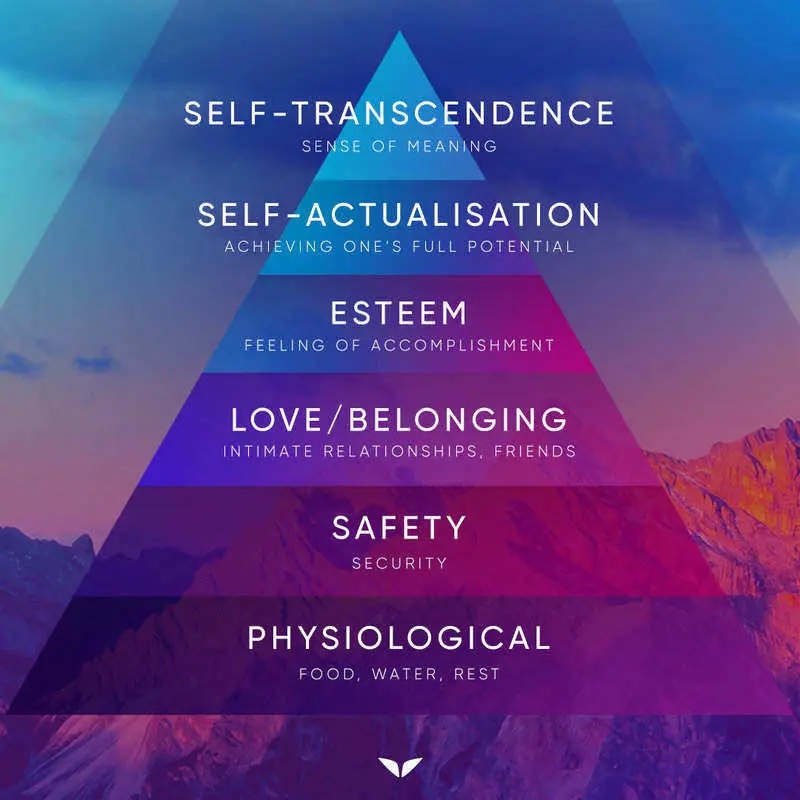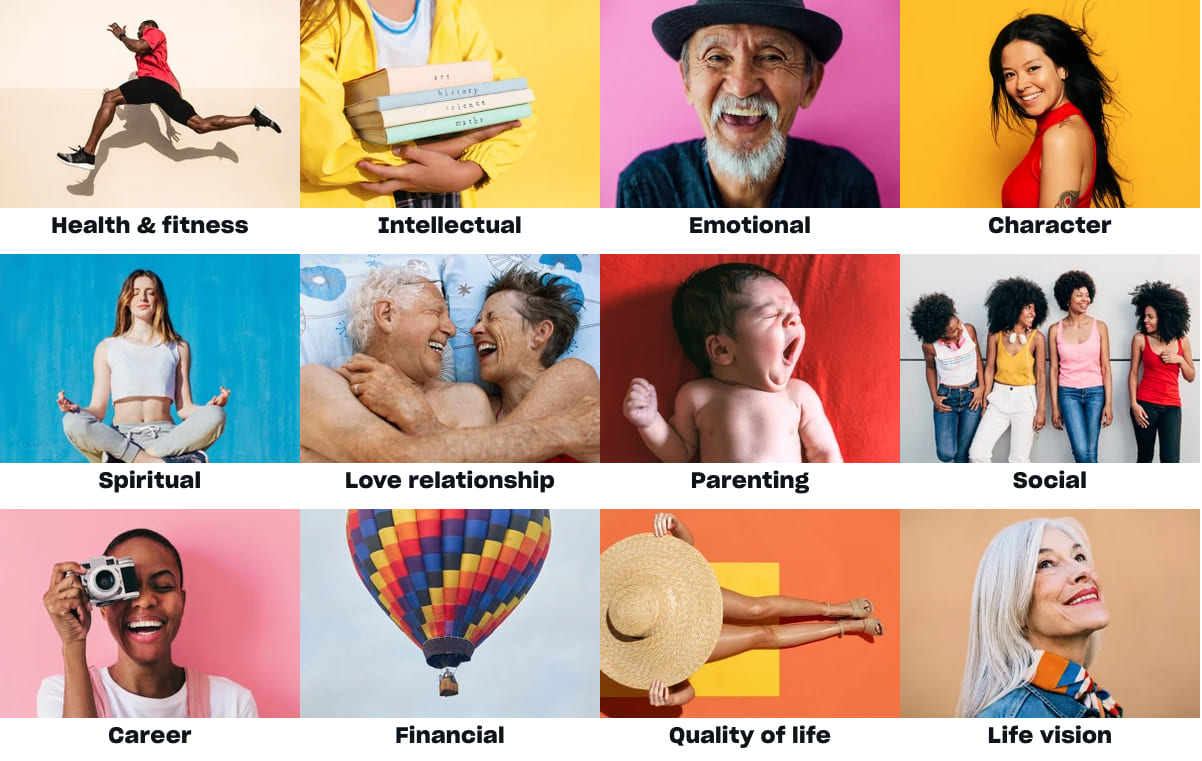Your life is your masterpiece. And it should be created by you.
So how do you create your pièce de résistance? Where do you even start?
Two words: life goals.
Now, this isn’t a new concept. In fact, there are numerous goal-setting methods out there that were created specifically to help set objectives and ways to achieve them.
There are the S.M.A.R.T. goals, the B.H.A.G., the HARD, the WOOP, the OGSM, the OKR…and all the non-acronym approaches. For the record, there’s nothing wrong with these methods; if it works for you, that’s wonderful!
However, if you find yourself giving up on your goals (as many of us do), you may just want to re-evaluate how you set them.
What Are Life Goals?
Life goals are more about what you want to achieve than what you want to accomplish. It’s set through envisioning, planning, and commitment. And because there are so many aspects of life, these goals could range anywhere from better relationships to starting a business to traveling the world.
The personal goals you choose to set for your life will drive your behaviors in the long run. It provides a sense of direction and makes you accountable as you strive for happiness and well-being for your best possible life.
Goals are instructions to yourself. Setting goals pulls you forward toward the object of your desire.
— Jon Butcher, trainer of Mindvalley’s Lifebook Quest
There’s no single psychological definition for them, and they aren’t strictly a clinical construct. However, they help to determine what you want to experience based on your values.
Goals vs. objectives
These two ideas are often used interchangeably. However, it’s important to note the differences between them.
- Goals are achievable outcomes that are generally broad and long-term.
- Objectives are specific, measurable actions taken in order to achieve a goal.
For example, if your goal is to climb the Himalayas, one of your objectives is to hike, gradually from short distances to long.
Both terms are essential to one another when it comes to planning and executing your dream life.
What are some life goals?
According to psychologists Tim Kasser and Richard M. Ryan, there are two types of life goals that relate to certain aspects of life:
- Intrinsic goals relate to emotional intimacy, personal growth, and helping others. They’re believed to be aligned with our human needs, reflecting our inherent desire for self-knowledge and more fulfilling relationships.
- Extrinsic goals are more culturally defined and less about our nature as human beings. They encompass things like our physical appearance, social standing, status symbols, and wealth.
In their 2001 paper, Kasser and Ryan suggest intrinsic life goals are related to greater happiness, self-actualization, vitality, and satisfaction with life compared with extrinsic life goals.
But at the end of the day, evidence also shows that why you want something matters more than what you want. And so, having the ‘right’ reason for goal pursuit — irrespective of the aspiration itself, that is — contributes more to your well-being.
Life goals based on Maslow’s Hierarchy of Needs
Intrinsic and extrinsic goals satisfy the needs that stem from being human, as based on Maslow’s Hierarchy of Needs (shown below).
Extrinsic goals cover physiological and safety. On the other hand, intrinsic goals are all about the end goals — belongingness and love, self-esteem, and self-actualization needs.

What are life goals examples?
When it comes to creating the life you love, you’ll want to aim for intrinsic goals rather than extrinsic ones. So here are what some life goals examples would look like:
Belongingness and love:
- Having a loving marriage or a trusting relationship with your significant other;
- Finding and keeping a healthy work-life balance, with time for friends and family; or
- Living with integrity, being honest and open with others.
Self-esteem:
- Inspiring others through your beliefs and actions;
- Being a great listener so that others can turn to you; or
- Becoming an expert in your field and helping others.
Self-fulfillment:
- Coming up with a new invention that reflects your creative abilities;
- Being a successful entrepreneur and running your own business; or
- Picking up a ‘hard skill’ and mastering it.
These are only some life goals ideas. As there are so many aspects of life and every one of us is unique, your personal aspirations may (or may not) be different.
Why Are Setting Goals Important?
We all have dreams and we know what makes us happy. But setting clear goals goes beyond wishful thinking and can fuel us towards actions.
Why do we bother to visualize what our future could be like?… We do it so that we can make it happen.
— Jon Butcher, trainer of Mindvalley’s Lifebook Quest
To paint a picture, here’s an analogy:
Did you ever play that party game, ‘Pin the Tail On the Donkey’?
One player would be blindfolded and spun into a dizzy frenzy before being set loose with a pin and a piece of string to blindly find the picture of an ass’ ass.
With good fortune, the player might pin the tail somewhere in the general vicinity of the donkey’s tushy. But, if fortune isn’t on their side, they might end up in a dizzy heap on the ground, much to the merriment of the rest of society.
Who’d have thought that a party game could be such a fitting metaphor for life?
Because when it comes to living our dream life, most of us are staggering around in the dark, hoping to stumble upon success. We rely on culturescape-based ideals, expecting them to lead us to a fulfilled life. Or we don’t have any goals at all.
By setting clear intentions on what kind of life we want, benefits can be reaped.
Benefits of goal setting
Having life goals in place is a catalyst for a bigger and better future. It can help transform your habits, mindset, confidence, and daily actions.
Without a doubt, the benefits are aplenty. And here are three key ones:
1. The goals you set affect your future
Here’s the secret of successful people:
- They figure out what they want, create their vision, and commit to their goals.
- Those get broken down into short-term goals with a step-by-step plan for each one.
- Then, successful people let nothing stand between them and the life they envision.
As radio speaker, Earl Nightingale says, “People with goals succeed because they know where they’re going.”
In Edwin Locke’s Theory of Goal-Setting, the act of setting goals and the thought we put into crafting them directs our attention to the why, how, and what of our aspirations. They give us something to focus on and positively impact our motivation.
And as we lay down our goals, it gives us something to commit to. This is called the ‘endowment effect,’ which happens when we take ownership of something and it becomes ‘ours,’ thereby integrating it into our sense of identity.
One older (but still valid) study demonstrated the endowment effect with a clever experiment. First, researchers gave participants coffee mugs and offered to trade them chocolate for their mugs. Almost none of the participants wanted to trade.
Next, researchers reversed the trial. They gave participants chocolate and then asked them to trade it for the coffee mug. Again, very few wanted to trade.
This is the endowment effect in action. It was about what they already had, not about the actual objects. When we take ownership of something, we work to keep it.
2. Goal-setting can promote happiness
When goals are based on values, they are meaningful. Meaning, purpose, and striving for something ‘bigger’ are key elements of happiness theory in positive psychology and the ‘M’ in Seligman’s PERMA model.
Along with positive emotion, relationships, engagement, and accomplishment (which goals allow for), it makes up what we’ve come to know as ‘the good life.’
In other words, life goals represent something beyond daily routines. They allow us to pursue authentic targets based on our values.
So, choosing them and going after them gives us a sense of profound self-accomplishment. According to eudaimonic well-being research, even striving to be the very best we can sometimes lead to happiness.
3. Life goals are empowering
When it comes to our life goals, to achieve them, we tend to tap into our inner strengths and passions. And knowing and using our inner strengths can:
- Increase our confidence,
- Boost our engagement, and
- Promote feelings of good health and life satisfaction.
“When you take the time to define an overall vision for your life that takes into consideration all the important aspects of your life, and then, you set goals against that, what that does is it aligns all of your goals,” explains Jon Butcher, trainer of Mindvalley’s Lifebook Quest. “They’re all moving in the same direction. They’re all working toward the same thing.”

How to Set Goals In Life
Most people have a vision of who or what they’d like to be, and perhaps, a dream of the kind of life they want to live. Even so, it can be hard to know where to start, and the things you want or hope to achieve seem impossible.
This is where Lifebook can help.
The lifestyle design system is all thanks to creators Jon and Missy Butcher, who designed and created a life so perfect that their friends (and even students prior to starting Lifebook) began to question what kind of voodoo they were practicing to make it happen.
Lifebook is essentially goal-setting redefined. It brings the ultimate expression of your life into reality by encouraging you to look at your ideal life from all angles — all 12 of them:

These 12 areas of life make up you and define your life. And they all ultimately lead to your life vision.
It is a step-by-step process, so here’s where you can start:
1. Set your premise
As you explore the dimensions of Lifebook, it’s important to understand your core belief in each. It’s a foundational belief upon which other beliefs are based, according to Jon.
So ask yourself:
- What do you believe?
- What deeply held beliefs are shaping your life?
- Are your beliefs empowering, or are they making you feel stuck in life?
Reflect on and write down what you believe to be true.
For example, if you’re looking at your health and fitness, your premise could be “I believe in listening to my body” or “My overall well-being is important to me.”
This step sets the tone and serves as a platform for all your actions related to that category.
2. Create your vision
This is about the ideal state you’d like to achieve. You can set the bar high and dream big.
Here are a few things to ask yourself as you’re doing so:
- How do you want this area of your life to feel?
- What do you want it to look like?
- If your life were exactly how you wanted it to be in each category, what would it consist of?
Reflect on and clearly describe your ideal vision.
Using health and fitness again as an example, your vision could include “I am full of energy and vitality, and radiate wellness” or “My body is strong, powerful, and resilient.”
3. Identify your purpose
It’s all about the ‘why’ in this step. It refers to the reasons behind what you want and determines whether or not you achieve it.
Ask yourself:
- Are there things that help energize you?
- What empowers you to take action?
- What motivates you to achieve your vision?
Reflect on and describe why you want to make the most out of each area of your life. Decide how much you really want it — what will you gain if you achieve and what will you lose if you don’t?
An example in health and fitness could be “My purpose is to stay youthful and resilient, to maximize my abilities and energy, to stay away from doctors and hospitals, and be pain-free into old age in order to enjoy it all.”
When your purpose is strong, you’ll do whatever it takes to overcome any obstacle to achieve your goal.
4. Come up with your strategy
Your strategy focuses on specific actions that will get you from where you are now to where you want to be. No matter how small or how big, your strategy will help you start moving toward the achievement of your goals and living the life you want.
So ask these questions:
- How will you bring your vision to reality?
- What kind of positive habits, attitudes, and action steps can you implement?
- What’s the recipe for the vision you want to create in each area of Lifebook?
In health and fitness, for instance, your strategy could include “What goes in my body creates my body, so I will always make sure it’s beautiful, nutritious, and clean” or “My recipe for optimum health and wellness is based on consistency.”
This step may require the support of other people, like a life coach or a tribe.
Remember: Lifebook helps you create a holistic, crystal-clear vision for your life. This framework of premise-vision-purpose-strategy framework to get clarity in each of the 12 categories.
And when you do, chances are, you’ll discover that life is good because you made it that way.

How to Achieve Goals In Life
Setting goals is one thing, but following through with that commitment is another. So taking notes from Jon and Missy Butcher’s Q&A session at Mindvalley’s A-Fest 2018 in Bali, here are five key ways to help you achieve your life goals.
1. Right-sizing your life vision
Right-sizing is when you convert something to an appropriate or optimum size. So when it comes to your life vision, you want to right-size it to make your life more efficient and meet your goals.
In order to do so, Jon and Missy have come up with four questions that will help you identify whether you’ve set the bar too high, too low, or just right.
Why’s this important? If you set the bar too low, you’re not going to feel fulfilled and if it’s too high, you’re not going to achieve it. So, taking a cue from Goldilocks, your bar has to be “just right.”
Actions to take: Ask yourself the following questions.
- When I look at my life vision, am I asking enough of myself? Or am I playing too small or too big?
- Is this vision achievable or am I asking too much of myself?
- Am I willing to pay the price that this life vision will require?
- Will the achievement of my life vision and the journey on the way to this vision make me truly happy and truly fulfilled?
If you’re able to answer them with a ‘yes,’ you can be certain that you’ve set the bar in relatively the right place. If not, you may want to look at modifying it.
2. Align your goals to your life vision
This step requires you to define your foundational goals. These are a handful of goals that if you achieve, you’ll be living that life vision.
“This is basically about identifying the most important things in your life and putting most of your energy there,” Jon advises.
Actions to take: Define at least five foundational goals. And make sure they align with your life vision.
3. Align your habits to your goals and life vision
As entrepreneur Jim Rohn says, “Motivation is what gets you started. Habit is what keeps you going.” And he’s got a great point.
Habits, good ones specifically, are important because they are the bedrock of your lifestyle. They don’t necessarily have to be something big; they can be small actions like drinking green juice every morning.
“It’s all about what you’re doing right now, like all the time, every time, every day,” says Missy. “And those things are what add up to your to your life and ultimately, to your life vision.”
Actions to take: Identify daily behaviors that will most support your life vision. For example, if one of your goals is to have a healthy body, then one habit you may want to improve on is to stop hitting the snooze button in the morning.
4. Step into your life vision
This step is about aligning your small daily choices and actions with your life vision. Missy explains it as “a level of consciousness that you bring to your everyday life.” Essentially, it’s your habits in action.
Take, for instance, the vision of having a great, loving relationship with your partner. This would require you to look at the daily actions you take in order to get there, like how you speak to them.
Actions to take: Reflect on your current daily actions and identify which ones will help you get to your life goals. If there are those behaviors that need to be transformed, then note them down and work on them.
5. Pay attention to your results
In order for your life vision to manifest, you need to understand whether or not you’re getting farther or closer to it.
Sometimes, we are so caught up in moving toward our goals that we forget to assess those goals and see if those goals really right for us.
— Vishen, founder of Mindvalley
So it’s important to take some time to look at the results of your goals. It’ll help you better understand what works and if there are any blockers you may have.
Actions to take: Track your goals and do a review of them every quarter or bi-annually. Take note of which habits, actions, and objectives worked for you and which didn’t.
For those that did, reflect if there are other ways to do them more efficiently. And for those that didn’t, explore how to improve on them.

Great Change Starts With You
Life can feel like it doesn’t belong to you. You feel like you’re stuck in the never-ending cycle of ‘work, eat, sleep, repeat.’ And seeing everyone else’s fabulous life on social media leaves you with the dreaded FOMO (fear of missing out).
The reality is, your dream life will continue being a dream until you make the effort to do something about it. As Jon says, “Greatness requires great effort.”
And if you’re ready to become the author of your best life and step into your greatness, Jon and Missy are waiting for you at Mindvalley’s Lifebook Quest.
There, you’ll be guided through every step of creating your own Lifebook. And chances are, you’ll end up finding who you really are, what you really want, and precisely how to realize your vision of your ultimate life.
It’s time to step into your greatness. Welcome in.









